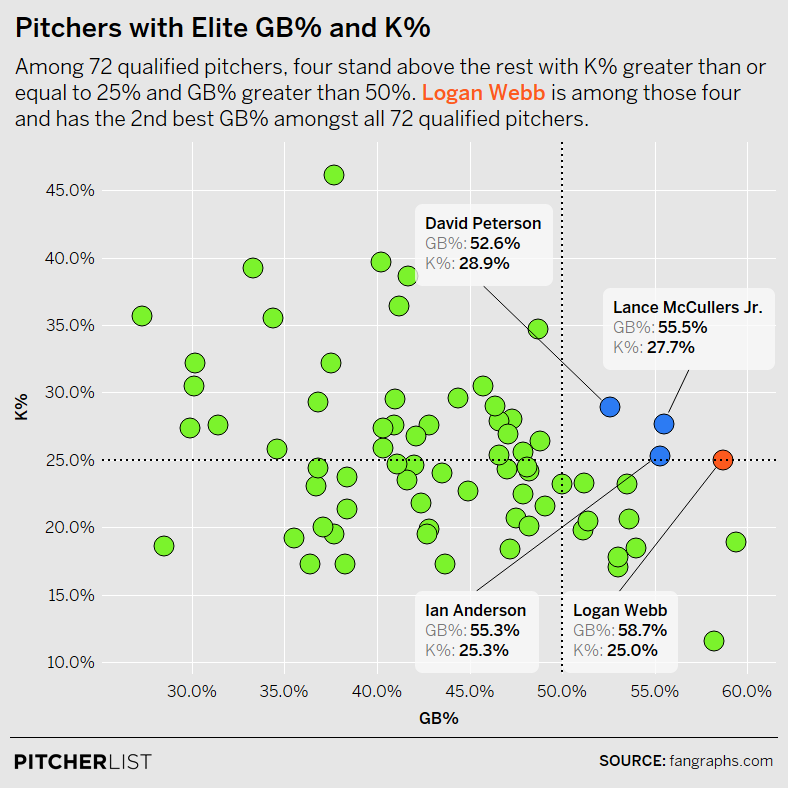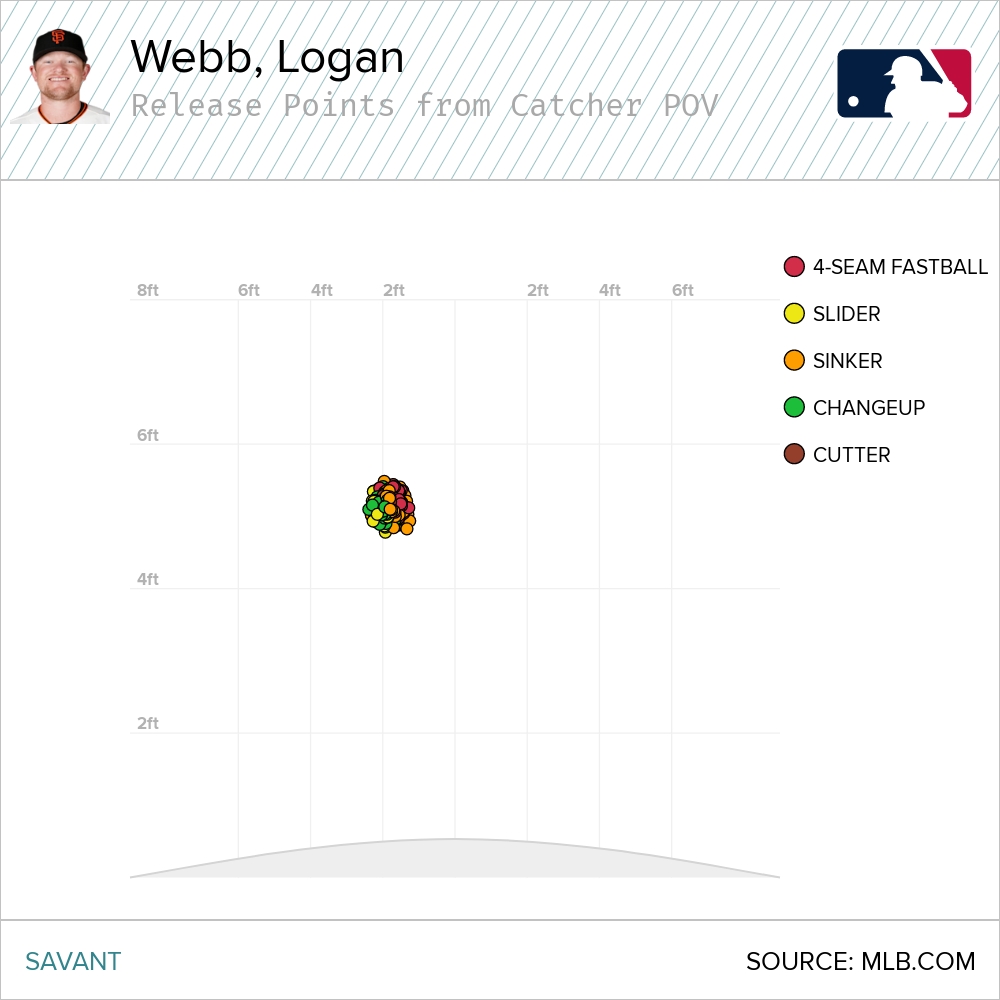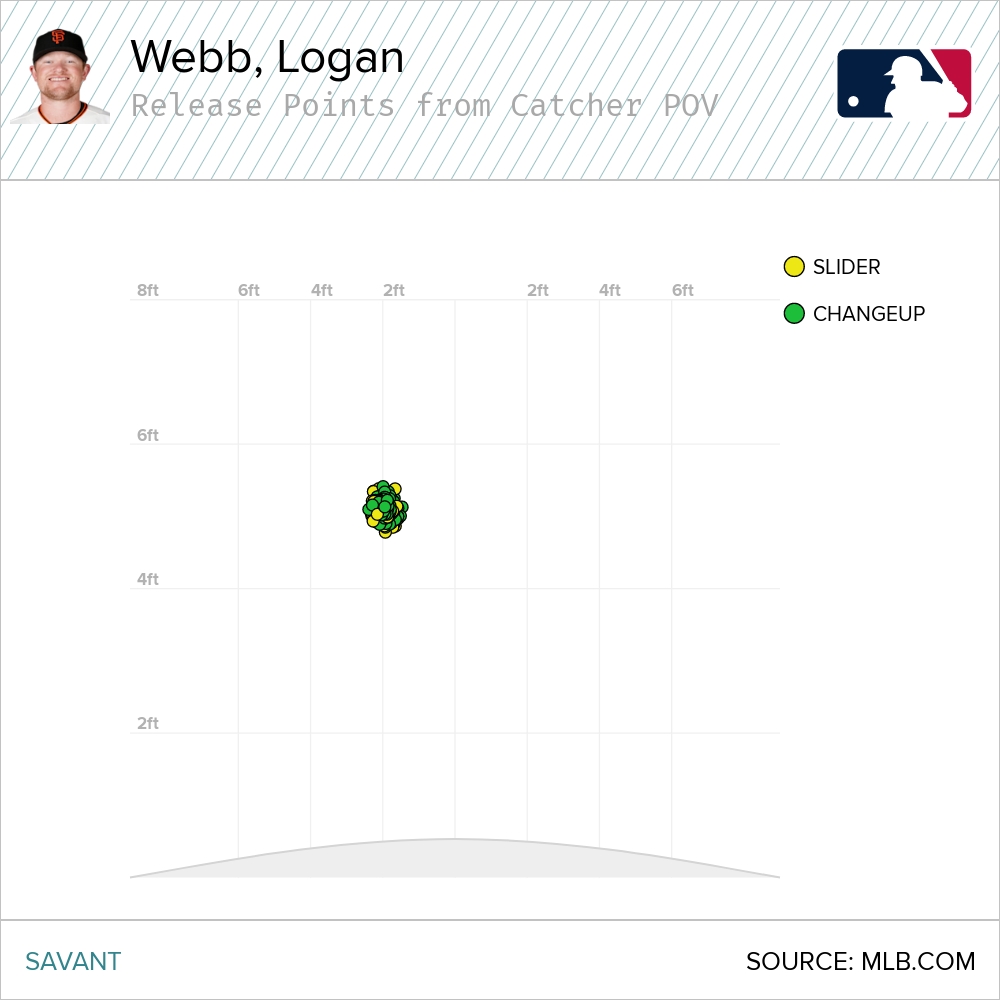The San Francisco Giants have opened the season as one of the hottest teams in the league. They’ve been kickstarted by a great pitching staff that ranks in the top third of the league in fWAR, SIERA, and ERA-. While names like Kevin Gausman and Alex Wood have led the charge for the starting staff, it’s Logan Webb who has the most potential to take the rotation to the next level. The 24-year-old has grown into a reliable starter but his ability to create weak contact on the ground and development of his command can take Webb from a promising pitcher to a reliable front-of-the-rotation stud.
Webb was placed on the IL Thursday, May 20th with a mild shoulder strain and should return at the end of the month per Roto Wire. All statistics are updated through the morning of May 20th and will not reflect any games played on May 20th
A Ground Ball Machine
Logan Webb is not a typical sinker primary pitcher. He only throws the pitch about 31% of the time, matched with his changeup at 29% of the time and his slider at 21% of the time. While the average launch angle a pitcher induces is misleading, because the low end and high ends of the spectrum can distort the result, the highest average launch angle he gets on those pitches is four degrees. The lowest ground ball rate he has on one of those pitches is 47% per baseball savant. According to the FanGraphs leaderboards, Webb is ranked second in ground ball rate in baseball among qualified starters. Webb gets players to beat the ball in the ground a lot for a multitude of reasons.
First, Webb throws a lot of pitches down in the zone and out of the zone. Among those three main pitches already mentioned, almost 60% of his pitches are thrown low in the zone or below it. If we removed the sinker from that equation, 70% of his changeups and sliders are located in the same areas. He’s making the effort to keep his off-speed pitches low in the zone. To put that in perspective, the league average rate for off-speed and breaking pitches in the same area is 55%. It’s going to be hard to hit balls up in the air when those three pitches are constantly being throw at your knees or lower. Especially with the way that Logan Webb’s sinker moves.
I have stated before that if you’re going to throw a sinker, you need to have it look very different than your fastball or get elite movement on the pitch to be successful with it. Logan Webb does both of those things extremely well. Webb’s fastball and sinker come out of the hand at similar points but they move in entirely different ways. While Webb’s four-seam fastball generates some run and drops way too much, his sinker gets well above average run and a lot of vertical break on it as well. There’s a deviation in his spin-based spin direction and observed spin direction which is a good sign for seam-shifted-wake to be present in Webb’s sinker. His spin efficiency on the pitch has dropped from 2020 to 2021 which means he is getting more gyro spin on the ball which would confirm that to be the case as well. Webb’s sinker moves so much that it is tough to barrel up. He’s given up one barrel on the pitch all year long. That’s a good way to have guys beat the ball into the ground is having a sinker with a lot of vertical break commanded low in the zone.
Webb is going to find more success if he can continue to keep hitters putting the ball on the ground. He’s a unique breed of strikeouts and groundballs as we can see in this chart below.

Data Visualization by @Kollauf on Twitter
If you’re one of four pitchers to have a strikeout rate above 25% and a groundball rate above 50%, you’re probably going to be very successful in this league. His problem is that he is having some command issues to open the season.
Developing Command
Webb’s main issue as a starter in his career has been middle of the road walk rate. While a 9% walk rate is close to average this year, it is going to hold him back from being an elite starter. A 1.41 WHIP is going to hurt his fantasy value a lot as well and he’s capable of much more than that. Webb’s ability to create so much contact on the ground will mean his ERA and ERA estimators will always be favorable to him, but they will limit what he could turn into.
For starters, Webb has never had a zone rating above 48% and 42% on FanGraphs. Throwing more pitches in the strike zone will probably help. He starts them with a first-pitch strike at an average rate, but his changeup/slider combo is only thrown in the zone about 33% of the time. That creates those ground balls as I mentioned but the downside is he can fall behind in the count. A tradeoff that I’m sure Webb can live with for now, but he should think about getting a few more of those pitches in the zone.
He does get hitters to chase his pitches out of the strike zone at an above-average rate this year which to me says he is making his pitches look like strikes more. Over his past three starts and in six of his last seven starts he’s recorded a swinging strike above 10% as well, another encouraging sign. His walk rate in the last four starts is under eight percent and that includes a start at Coors Field. He appears to be taking some steps forward recently, but those trends will need a bigger sample size for me to believe in it. To see the true improvement in Webb’s game, just look for his zone% on FanGraphs. If it’s around 40%, then he should be successful.
Because of the ground ball ability Webb has, his WHIP will always be higher because some of those balls will sneak through for hits. To get that value lower, he will need to improve the walk rate. One of the fastest ways to do that is to improve his command and feel for his changeup.
Improving the Change
On paper, there are a lot of things to like about Logan Webb’s changeup. His changeup gets 23% more vertical break on it than changeups of similar characteristics. He is employing some seam shifted wake on the pitch as well as he incorporates more gyro degree on the ball and that’s helping create that drop. The pitch doesn’t get a lot of arm side movement as it is well below average in that regard. Yet, the pitch only has a 23.9% CSW, the lowest of his main three pitches. His slider has a 41% CSW which is fantastic, and his sinker has a 31% rate which is roughly around average. What gives?
Webb throws his changeup for a called strike just 8% of the time. The league average rate is 10%. He does have a 15.8% swinging strike rate which is an average rate, but he just isn’t getting enough called strikes on the pitch to have it be effective. It’s been worth +5 runs according to baseball savant, by far the worst rate among his pitches. Part of that is because the pitch is registering an unusually high .383 BABIP and he’s given up two home runs on the pitch as well. There is some bad luck involved in the pitches performance early but it’s also a command issue.
He’s getting more ground balls on the pitch this year than he did in years past, but his called strike rate on the pitch fell by nearly 8% from 2020 to 2021. Something Webb can do, and any pitcher should do if they have solid changeup is thrown it on the first pitch more. Webb has faced 188 batters this year and has thrown a first-pitch changeup just 31 times. It’s resulted in a first-pitch strike only about half the time and hitters have 2 hits and 4 at-bats ending on first pitch changeups. He does throw it in the zone more though early in the count, he just doesn’t throw it early in the count a lot as it’s one of his putaway pitches. His slider has developed into such a weapon for him though that he should start using his changeup as a potential setup pitch. Hitters can’t tell the difference out Webb’s hand on his pitches but even more so on his changeup and slider.


That’s a serious advantage that Webb has with off-speed pitches is they look the same coming out of his hand. He can use one to set up the other. Webb’s slider has good vertical break and glove-side run. He can tunnel the pitches off of each other well to get some more outs. When he pitches himself into a jam where he needs to get a ground ball, he can turn to multiple different pitches to try and get out of it. Pitching backwards may help Webb’s early-season changeup issues.
While Webb has commanded a 4 ERA after a tough start in Coors Field, a near 60% ground ball rate paired with a 25% strikeout rate has put himself in some elite company. Matched with career-best FIP-, xFIP-, and SIERA values, Logan Webb is on the verge of frontline fantasy production if he can continue to improve his command and work out the issues with his changeup. The Rocklin, California native, where I once lived, has all of Northern California cheering him on, it’s time for him to take that final step forward to greatness.
Photo by Rich Graessle/Icon Sportswire | Adapted by Doug Carlin (@Bdougals on Twitter)
